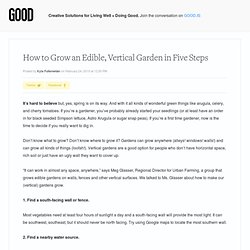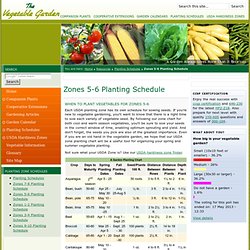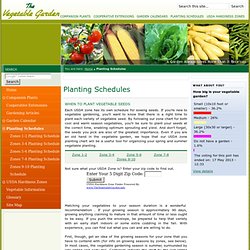

How to Grow an Edible, Vertical Garden in Five Steps - Cities. It’s hard to believe but, yes, spring is on its way.

And with it all kinds of wonderful green things like arugula, celery, and cherry tomatoes. If you’re a gardener, you’ve probably already started your seedlings (or at least have an order in for black seeded Simpson lettuce, Astro Arugula or sugar snap peas). If you’re a first time gardener, now is the time to decide if you really want to dig in. Don’t know what to grow? Don’t know where to grow it? “It can work in almost any space, anywhere,” says Meg Glasser, Regional Director for Urban Farming, a group that grows edible gardens on walls, fences and other vertical surfaces. 1. Most vegetables need at least four hours of sunlight a day and a south-facing wall will provide the most light. 2.
A local, dependable, water source is one of the most critical components—without it you will need to consider another site. 3. 3. You can start with seeds or seedlings but if you’re starting in later spring, use seedlings. 4. Bonus tips! The Vegetable Garden: Zones 5-6 Planting Schedule. When to Plant Vegetables For Zones 5-6 Each USDA planting zone has its own schedule for sowing seeds.

If you're new to vegetable gardening, you'll want to know that there is a right time to sow each variety of vegetable seed. By following our zone chart for both cool and warm season vegetables, you'll be sure to sow your seeds in the correct window of time, enabling optimum sprouting and yield. And don't forget, the seeds you pick are also of the greatest importance.
Even if you are an old hand in the vegetable garden, we hope that our USDA zone planting chart will be a useful tool for organizing your spring and summer vegetable planting. Not sure what your USDA Zone is? This schedule is a general guide for the zone, please check with your local extension office for precise information for your specific area. 8013.pdf (application/pdf Object) Michigan Interactive USDA Plant Hardiness Zone Map. Frost dates last spring frost first fall frost. First and last freeze/frost dates for East Lansing, MI 48823, USA. 25+ Clever Ideas Gardeners Won’t Want To Miss. Did you know you can make your own rooting hormone using willow twigs?

Or that geraniums can be overwintered? How about a few ideas for soil savers, pest control and fighting weeds? You’ll find all that and more in this collection! First, here’s an interesting tip I came across while reading the book “The Essential Urban Farmer”, did you know that willow trees contain a lot of natural rooting hormone that you can tap into for your own cuttings? Here’s how to make it: 15 to 20 thin twigs (any variety of willow tree) gallon of water Directions: Place the twigs in a bucket then top with water, cover with lid.
To Use: Place cuttings in the water solution a day before potting. Storage: Can be refrigerated for up to one month. Ready to check out the rest of the goodies? PS: I’ll be adding more goodies to this list as I find them so you may want to bookmark this page! Ladybirdln.com Diaper Liners: Line the bottom of baskets and pots with a disposable diaper to help retain soil moisture. hgtv.com. Www.extension.iastate.edu/Publications/PM814.pdf. GrowGuide Vegetable Garden Planner. The Vegetable Garden: Planting Schedules. When to Plant Vegetable Seeds Each USDA zone has its own schedule for sowing seeds.

If you're new to vegetable gardening, you'll want to know that there is a right time to plant each variety of vegetable seed. By following our zone chart for both cool and warm season vegetables, you'll be sure to plant your seeds at the correct time, enabling optimum sprouting and yield. And don't forget, the seeds you pick are also of the greatest importance.
Even if you are an old hand in the vegetable garden, we hope that our USDA zone planting chart will be a useful tool for organizing your spring and summer vegetable planting. Zone 1-2 Zone 3-4 Zone 5-6 Zone 7-8 Zones 9-10 Not sure what your USDA Zone is? Matching your vegetables to your season duration is a wonderful recommendation . First, though, get an idea of the growing seasons for your zone that you have to contend with (for info on growing seasons by zones, see below). You can even produce some veggies during the winter.